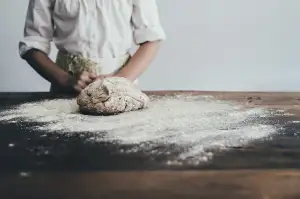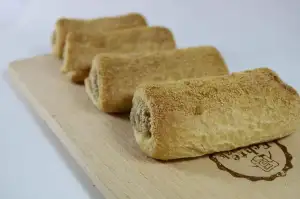Delicious Dutch Oven Bread Recipes: A Must-Try for Bread Enthusiasts

Dutch oven bread recipes have been gaining popularity among bread enthusiasts for their unique and delicious results. This traditional method of baking bread involves using a heavy, cast-iron pot with a tight-fitting lid, which creates the perfect environment for achieving a crusty exterior and soft, moist interior. Whether you're a seasoned baker or just starting out, exploring the world of Dutch oven bread recipes is sure to elevate your baking game. In this article, we will delve into the benefits of baking bread in a Dutch oven, essential tools and ingredients needed, basic recipe variations, tips and tricks for successful baking, as well as answer frequently asked questions about this technique. Get ready to embark on a mouthwatering journey with these must-try Dutch oven bread recipes!
Benefits of Baking Bread in a Dutch Oven
Baking bread in a Dutch oven has several advantages that make it a popular choice among bread enthusiasts. Firstly, the Dutch oven's thick and heavy construction helps to create an ideal baking environment. The cast iron or enameled surface retains heat efficiently and distributes it evenly, resulting in a perfectly golden and crispy crust.
The enclosed space of the Dutch oven also traps steam released from the dough during baking. This steam creates moisture inside the pot, which is crucial for achieving a soft and tender crumb. The combination of heat retention and steam ensures that the bread bakes evenly, with a light and airy texture.
Furthermore, using a Dutch oven allows for better control over the baking process. The tight-fitting lid helps to seal in moisture and prevents the bread from drying out during baking. This results in a loaf with a moist interior and excellent flavor development.
Another benefit of using a Dutch oven is its versatility. Apart from baking bread, it can be used for various other cooking techniques such as braising, roasting, and even deep-frying. This multi-purpose functionality makes it an essential tool in any kitchen.
In summary, baking bread in a Dutch oven offers numerous benefits including even heat distribution, steam retention for optimal texture, moisture preservation, excellent flavor development, and versatility in cooking techniques. These advantages make it an indispensable tool for bread enthusiasts looking to achieve professional-quality loaves at home.
Essential Tools and Ingredients for Dutch Oven Bread
When it comes to baking bread in a Dutch oven, having the right tools and ingredients is essential for achieving that perfect loaf. Here are some must-have items:
1. Dutch Oven: A heavy-duty cast iron or enameled Dutch oven with a tight-fitting lid is crucial for trapping steam and creating a crispy crust.
2. Oven Thermometer: To ensure accurate temperature control, use an oven thermometer to monitor the heat inside your oven.
3. Bread Lame or Razor Blade: This tool is used to score the dough before baking, allowing it to expand properly during the baking process.
4. Parchment Paper: Using parchment paper helps prevent sticking and makes transferring the dough into the hot Dutch oven much easier.
5. High-Quality Flour: Opt for high-protein flours like bread flour or all-purpose flour for best results. These flours provide structure and help develop gluten.
6. Yeast or Sourdough Starter: Depending on your preference, you can use either commercial yeast or a sourdough starter to leaven your bread.
7. Salt: Salt not only enhances flavor but also helps control fermentation and strengthens gluten development.
8. Water: Use filtered water at room temperature for mixing your dough. Chlorine in tap water can inhibit fermentation.
By having these essential tools and ingredients on hand, you'll be well-equipped to embark on your Dutch oven bread-baking journey with confidence!
Basic Dutch Oven Bread Recipe
To get started with Dutch oven bread, you'll need the following ingredients: 3 cups of all-purpose flour, 1 ½ teaspoons of salt, 1 ½ teaspoons of active dry yeast, and 1 ½ cups of warm water.
Begin by combining the flour, salt, and yeast in a large mixing bowl. Gradually add the warm water while stirring with a wooden spoon until a sticky dough forms. Cover the bowl with plastic wrap and let it rise for about 12-18 hours at room temperature.
After the dough has risen, preheat your oven to 450°F (230°C) and place a Dutch oven with its lid on inside to heat up for about 30 minutes.
Meanwhile, generously flour a clean surface and transfer the dough onto it. Gently shape it into a round loaf by folding the edges towards the center. Let it rest for another 30 minutes.
Carefully remove the hot Dutch oven from the oven and remove its lid. Place the shaped loaf into the pot and cover it with the lid. Bake for 30 minutes covered, then remove the lid and bake for an additional 15-20 minutes until golden brown.
Once baked, carefully remove the bread from the Dutch oven using oven mitts or kitchen towels. Allow it to cool on a wire rack before slicing.
This basic Dutch oven bread recipe yields a crusty exterior with a soft and chewy interior. It's perfect for enjoying fresh out of the oven or using as a base for sandwiches or toast.
Variations of Dutch Oven Bread Recipes
Dutch oven bread recipes offer endless possibilities for creativity in the kitchen. Here are some popular variations to try:
1. Whole Wheat Dutch Oven Bread: For a healthier option, substitute part or all of the all-purpose flour with whole wheat flour. This adds a nutty flavor and boosts the nutritional value of your bread.
2. Herb and Cheese Dutch Oven Bread: Add dried herbs like rosemary, thyme, or basil to the dough for an aromatic twist. Sprinkle grated cheese on top before baking for a deliciously cheesy crust.
3. Olive and Garlic Dutch Oven Bread: Mix pitted olives and minced garlic into the dough to infuse it with Mediterranean flavors. The result is a savory bread perfect for pairing with soups or salads.
4. Cinnamon Raisin Dutch Oven Bread: Sweeten things up by incorporating cinnamon and raisins into the dough. This variation is ideal for breakfast or as a tasty snack.
5. Seeded Dutch Oven Bread: Boost texture and nutrition by adding a variety of seeds such as sesame, flax, sunflower, or pumpkin seeds to the dough. These seeds add crunch and enhance the flavor profile.
Experimenting with different ingredients allows you to tailor your bread to your taste preferences and dietary needs. Get creative and enjoy exploring these variations!
Tips and Tricks for Successful Dutch Oven Bread Baking
1. Preheat the Dutch oven: To ensure a crispy crust, preheat your Dutch oven along with the oven. This will help create a burst of steam when you place the dough in, resulting in a beautiful golden crust.
2. Use parchment paper: Line the bottom of your Dutch oven with parchment paper before placing the dough inside. This will prevent it from sticking to the pot and make it easier to remove once baked.
3. Score the dough: Before baking, score the top of your bread with a sharp knife or razor blade. This allows steam to escape during baking and helps create an attractive pattern on the loaf.
4. Control moisture levels: If you prefer a softer crust, keep the lid on for the entire baking time. For a crustier bread, remove the lid during the last 10-15 minutes of baking.
5. Experiment with different flours: Don't be afraid to try different types of flour in your Dutch oven bread recipes. Whole wheat, rye, or spelt flour can add unique flavors and textures to your loaves.
6. Add ingredients for flavor: Enhance your bread's taste by incorporating herbs, spices, cheese, nuts, or dried fruits into the dough. These additions can take your Dutch oven bread to another level of deliciousness.
7. Allow proper resting time: After removing your bread from the Dutch oven, let it cool completely on a wire rack before slicing into it. This allows for even distribution of moisture and ensures a better texture.
Remember that practice makes perfect when it comes to baking bread in a Dutch oven. Don't get discouraged if your first attempts are not exactly as you envisioned – keep experimenting and refining your technique until you achieve that perfect loaf!
Frequently Asked Questions about Dutch Oven Bread
1. Can I use any type of Dutch oven for baking bread?
Yes, you can use any type of Dutch oven for baking bread as long as it has a tight-fitting lid and is oven-safe. Cast iron or enameled cast iron Dutch ovens are popular choices due to their ability to retain heat evenly.
2. Do I need to preheat the Dutch oven before baking bread?
Yes, it is crucial to preheat the Dutch oven before adding the bread dough. Preheating helps create a crispy crust and ensures even baking throughout.
3. How do I prevent the bread from sticking to the Dutch oven?
To prevent sticking, you can lightly grease the inside of the Dutch oven or line it with parchment paper before placing the dough inside. This will make it easier to remove the bread once it's baked.
4. Can I use a glass or ceramic dish as a substitute for a Dutch oven?
While glass or ceramic dishes can be used as substitutes, they may not retain heat as effectively as a cast iron Dutch oven. This could result in less desirable crust and texture.
5. How long should I let the bread cool in the Dutch oven after baking?
It's recommended to let the bread cool in the Dutch oven for around 10-15 minutes before removing it. This allows steam to escape and prevents condensation from making the crust soggy.
6. Can I bake other types of bread besides sourdough in a Dutch oven?
Absolutely! A Dutch oven is versatile and can be used for various types of bread recipes, including whole wheat, rye, and artisan loaves. The enclosed environment helps create an ideal baking environment for all kinds of bread.
Remember, experimenting with different recipes and techniques will help you discover your favorite variations of delicious Dutch oven-baked bread!
In conclusion, Dutch oven bread recipes are a must-try for bread enthusiasts. Baking bread in a Dutch oven offers numerous benefits, including a crispy crust and moist interior. The essential tools and ingredients for Dutch oven bread include a cast iron or enamel-coated pot, high-quality flour, yeast, salt, and water.
The basic Dutch oven bread recipe is simple yet yields delicious results. However, there are also various variations to explore, such as adding herbs, cheese, or even fruits and nuts to the dough. These variations allow for endless possibilities and flavors.
To ensure successful Dutch oven bread baking, it's important to preheat the pot properly and use parchment paper or cornmeal to prevent sticking. Additionally, using the right amount of steam during baking helps create a beautiful crust.
Frequently asked questions about Dutch oven bread often revolve around choosing the right size of the pot or adjusting baking times. It's recommended to experiment with different techniques and recipes until finding the perfect fit.
In conclusion, Dutch oven bread recipes provide a unique experience in bread baking. The combination of simplicity and versatility makes them an excellent choice for both novice bakers and seasoned professionals. So why not give it a try? Get inspired by these delicious recipes and embark on your own culinary journey with Dutch oven bread!
Published: 20. 02. 2024
Category: Recipes



